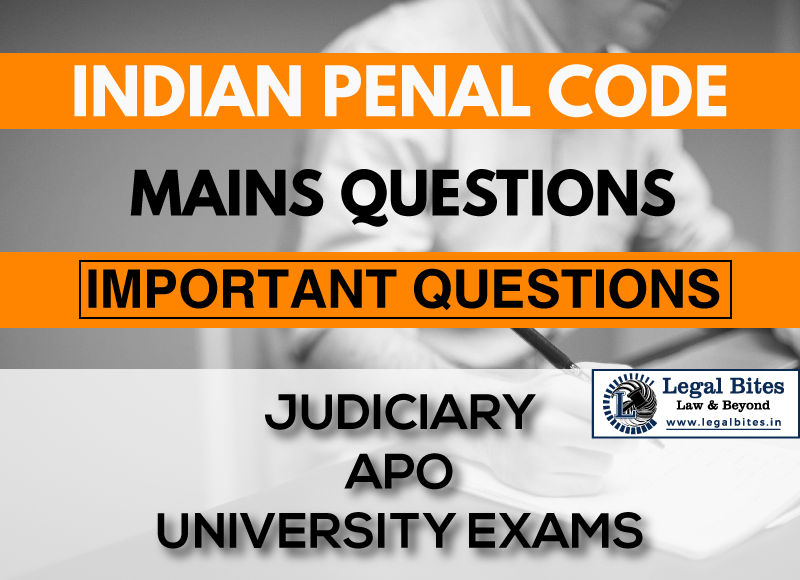P, Q, and R had a common intention to rob S. While P and Q entered into the house of S and beat and robbed him, R stood outside to warn P and Q of any danger......
Find the answer to the mains question of IPC only on Legal Bites.

Question: P, Q, and R had a common intention to rob S. While P and Q entered into the house of S and beat and robbed him, R stood outside to warn P and Q of any danger. On being prosecuted along with P and Q, R pleaded that neither did he commit the robbery nor cause injuries to S and hence was not guilty of any offence. Decide. [UPCJ, 1983] Find the answer to the mains question of IPC only on Legal Bites. [P, Q, and R had common intention to rob S. While P and Q entered into the house of...
Question: P, Q, and R had a common intention to rob S. While P and Q entered into the house of S and beat and robbed him, R stood outside to warn P and Q of any danger. On being prosecuted along with P and Q, R pleaded that neither did he commit the robbery nor cause injuries to S and hence was not guilty of any offence. Decide. [UPCJ, 1983]
Find the answer to the mains question of IPC only on Legal Bites. [P, Q, and R had common intention to rob S. While P and Q entered into the house of S and beat and robbed him, R stood outside to warn P and Q of any danger. On being prosecuted along with P and Q, R pleaded that neither did he commit the robbery nor cause injuries to S and hence was not guilty of any offence. Decide.]
Answer
Section 34 of the code deals with the provision relating to ‘acts done by several persons in furtherance of common intention’ which is known as common intention. This section reads as follows-
“when a criminal act is done by several persons in furtherance of the common intention of all, each of such persons is liable for that act in the same manner as if it were done by him alone."
This provision which enunciates the principle of joint or constructive liability for a criminal act done in furtherance of a common intention of all embodies the principle of ruling in the English case R. v. Cruise (1838) 8 C and P 541. A police constable and his assistants went to arrest person A in his house. In that house, there were B, C, D, and certain others. These persons in order to prevent the arrest of A, came out to drive away from the police party.
In this joint attack of the police party, one of the assistants of the policeman was killed and it could not be found who it was that killed the victim, whether it was A or B or C or somebody else. It was held by the court that each of the attackers would be responsible in an equal measure for the criminal act, namely the blow, whether he actually struck it or not.
In the case of Mahboob Shah v. Emperor, (1945) 47 BOMLR 941 the court has given a close observation upon the distinction between the two. It says that section 34 lays down a principle of joint liability in the doing of a criminal act. The section does not say the common intention of all, nor does it say an intention common to all. The essence of the liability is to be found in the existence of a common intention animating the accused leading to the doing of a criminal act in furtherance of such intention.
To involve the aid of Section 34 successfully, it must be shown that the criminal act complained against was done by one of the accused persons in furtherance of the common intention of all; if this is so then liability for the crime may be imposed on any one of the persons in the same manner as if the act were done by him alone.
Applying the arguments of the above case laws, it is clear that claims of R that he was not guilty is not correct because the case invokes the applicability of section 34 it is sufficient for the punishment to be followed that the parties involved had the common intention and something was done on their part in the furtherance of that intention, even if that part was to stand out and warn P of any danger.
Important Mains Questions Series for Judiciary, APO & University Exams
- IPC Mains Questions Series Part I: Important Questions
- IPC Mains Questions Series Part II: Important Questions
- IPC Mains Questions Series Part III: Important Questions
- IPC Mains Questions Series Part IV: Important Questions
- IPC Mains Questions Series Part V: Important Questions
- IPC Mains Questions Series Part VI: Important Questions
- IPC Mains Questions Series Part VII: Important Questions
- IPC Mains Questions Series Part VIII: Important Questions
- IPC Mains Questions Series Part IX: Important Questions
- IPC Mains Questions Series Part X: Important Questions

Admin Legal Bites
Legal Bites Study Materials correspond to what is taught in law schools and what is tested in competitive exams. It pledges to offer a competitive advantage, prepare for tests, and save a lot of money.
